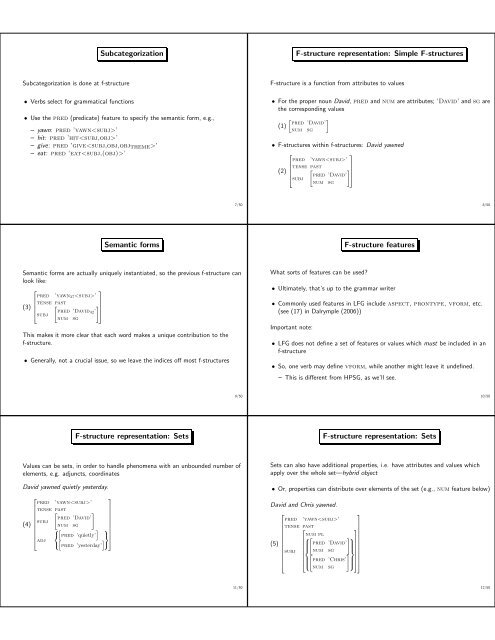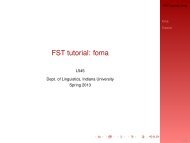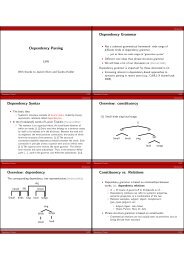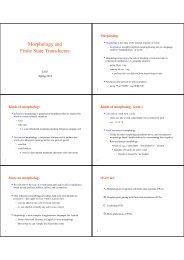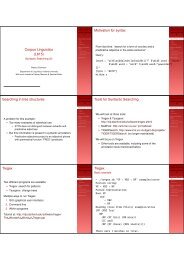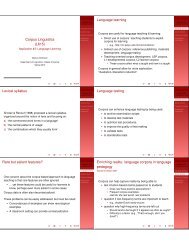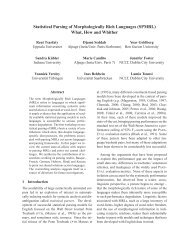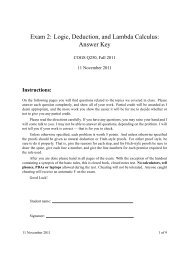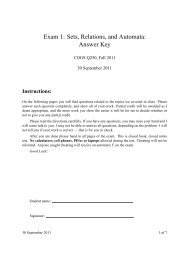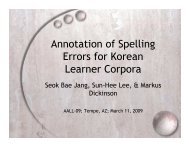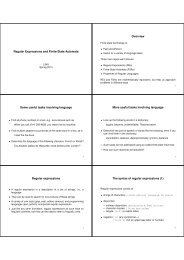Lexical-Functional Grammar (LFG) Motivation for LFG LFG in a ...
Lexical-Functional Grammar (LFG) Motivation for LFG LFG in a ...
Lexical-Functional Grammar (LFG) Motivation for LFG LFG in a ...
You also want an ePaper? Increase the reach of your titles
YUMPU automatically turns print PDFs into web optimized ePapers that Google loves.
Subcategorization<br />
F-structure representation: Simple F-structures<br />
Subcategorization is done at f-structure<br />
• Verbs select <strong>for</strong> grammatical functions<br />
• Use the pred (predicate) feature to specify the semantic <strong>for</strong>m, e.g.,<br />
– yawn: pred ’yawn’<br />
– hit: pred ’hit’<br />
– give: pred ’give’<br />
– eat: pred ’eat’<br />
F-structure is a function from attributes to values<br />
• For the proper noun David, pred and num are attributes; ’David’ and sg are<br />
the correspond<strong>in</strong>g values<br />
» –<br />
pred ’David’<br />
(1)<br />
num sg<br />
• F-structures with<strong>in</strong> f-structures: David yawned<br />
2<br />
3<br />
pred ’yawn’<br />
tense past<br />
(2)<br />
"<br />
#<br />
6<br />
4 pred ’David’ 7<br />
subj<br />
5<br />
num sg<br />
7/50<br />
8/50<br />
Semantic <strong>for</strong>ms<br />
F-structure features<br />
Semantic <strong>for</strong>ms are actually uniquely <strong>in</strong>stantiated, so the previous f-structure can<br />
look like:<br />
2<br />
3<br />
pred ’yawn 37’<br />
tense past<br />
(3)<br />
"<br />
#<br />
6<br />
4 pred ’David 42’<br />
7<br />
subj<br />
5<br />
num sg<br />
This makes it more clear that each word makes a unique contribution to the<br />
f-structure.<br />
• Generally, not a crucial issue, so we leave the <strong>in</strong>dices off most f-structures<br />
What sorts of features can be used?<br />
• Ultimately, that’s up to the grammar writer<br />
• Commonly used features <strong>in</strong> <strong>LFG</strong> <strong>in</strong>clude aspect, prontype, v<strong>for</strong>m, etc.<br />
(see (17) <strong>in</strong> Dalrymple (2006))<br />
Important note:<br />
• <strong>LFG</strong> does not def<strong>in</strong>e a set of features or values which must be <strong>in</strong>cluded <strong>in</strong> an<br />
f-structure<br />
• So, one verb may def<strong>in</strong>e v<strong>for</strong>m, while another might leave it undef<strong>in</strong>ed.<br />
– This is different from HPSG, as we’ll see.<br />
9/50<br />
10/50<br />
F-structure representation: Sets<br />
F-structure representation: Sets<br />
Values can be sets, <strong>in</strong> order to handle phenomena with an unbounded number of<br />
elements, e.g. adjuncts, coord<strong>in</strong>ates<br />
David yawned quietly yesterday.<br />
2<br />
3<br />
pred ’yawn’<br />
tense past<br />
"<br />
#<br />
pred ’David’<br />
(4)<br />
subj<br />
num sg<br />
8h<br />
i 9<br />
6<br />
< pred ’quietly’ =<br />
7<br />
4adj<br />
h<br />
i 5<br />
: pred ’yesterday’ ;<br />
Sets can also have additional properties, i.e. have attributes and values which<br />
apply over the whole set—hybrid object<br />
• Or, properties can distribute over elements of the set (e.g., num feature below)<br />
David and Chris yawned.<br />
2<br />
3<br />
pred ’yawn’<br />
tense past<br />
2<br />
3<br />
num pl<br />
8"<br />
# 9<br />
(5)<br />
pred ’David’<br />
subj<br />
><<br />
num sg<br />
>=<br />
"<br />
#<br />
6 6<br />
4 4 pred ’Chris’<br />
7<br />
>: num sg<br />
>;<br />
5<br />
11/50<br />
12/50


